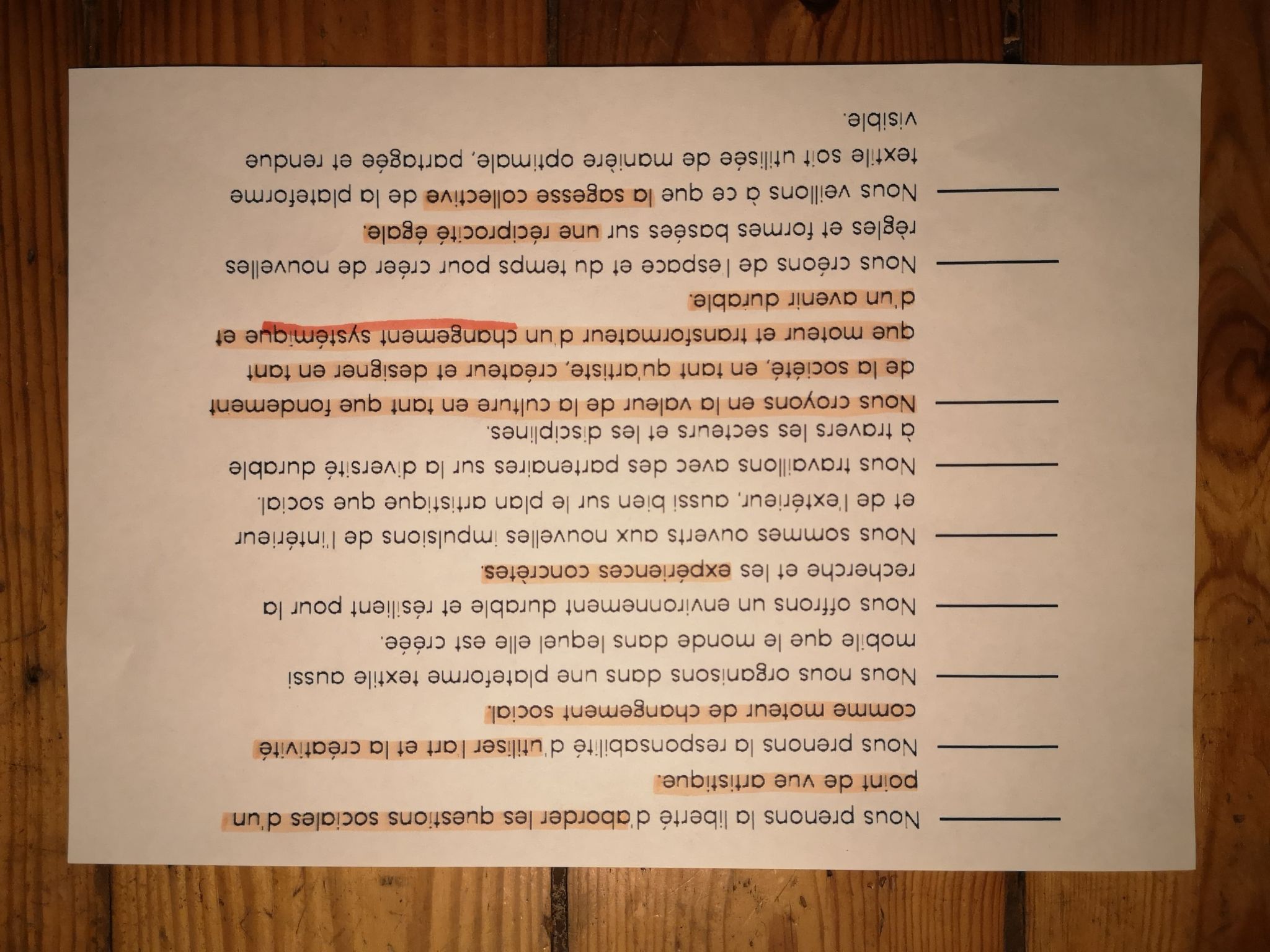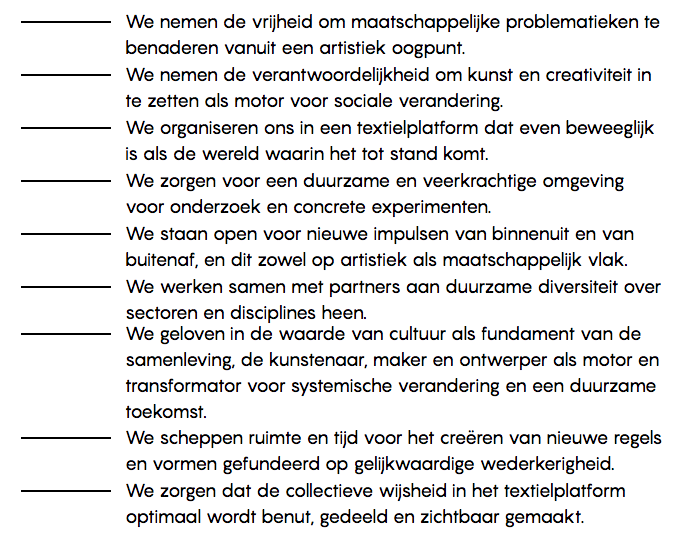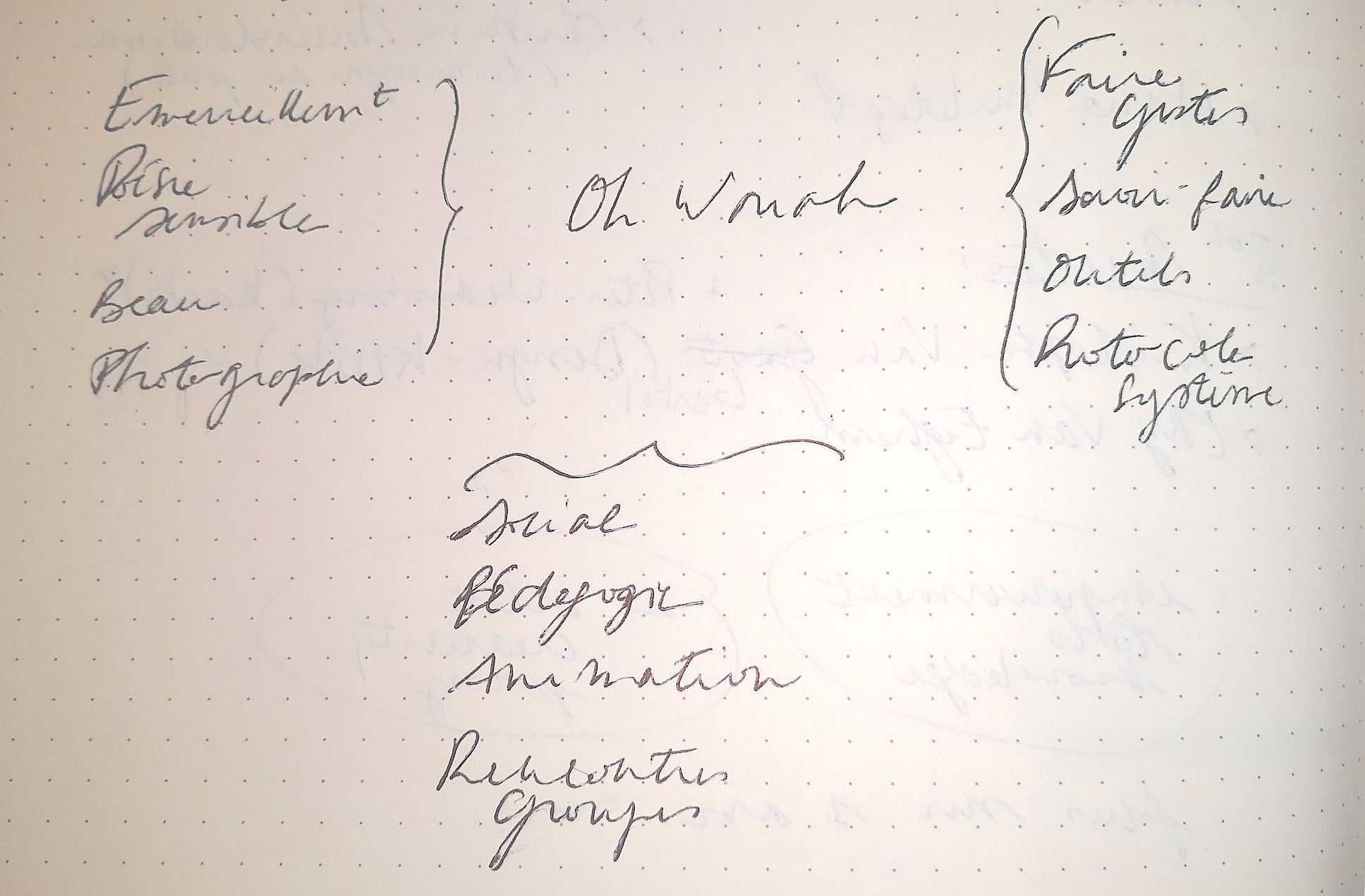Iefspincemaille
Big yarn to manipulate with a group
Travis Meinolf
Weaves in the street and to open a discussion with people
Assembly
Hana Miletiç
Works on felt with woman house
Paulin Dornat
Silkprinting work made with children and gomettes
Amish quilts
Women have to make one for their wedding, they use to receive help from sister, cousin, etc
The quilts are made with old clothes (without pattern)
Pictures taken in Benin - 2019
Clothes from second hand are re-use to take the yarn. That give to the veavers a higher quality of yarns.
Louise Bourgeois - Ode à l'oubli, 2004
Livre d'or fait à base de vêtements
« Il s’agira donc de se demander comment les artistes-femmes détournent le travail du fil, instrument d’oppression, pour en faire l’instrument de leur libération. »
« Ainsi, faire grand pour une artiste-femme, c’est sortir du cadre qu’on lui a fixé – la sphère domestique – et affirmer une présence dans l’espace public dont les femmes avaient été exclues. La conquête de l’espace extérieur se présente alors comme un en jeu d’émancipation artistique. »
« L’on constate ainsi que lorsque les femmes s’emparent du dehors, c’est très fréquemment de manière collective et solidaire. »
(A propos du travail de Ana Tereza Barboza et Orly Genger)
"écouter le bourdonnement de la vie quotidienne"
- Mierle Laderman Ukeles
(egologist and feminist artist)




"Rebelles"
Exhibition in the Clermont Ferrand museum
>In Afghanistan women weave kalachnkiovs and missiles on rugs to rebel
>In southern Morocco, the Yaz checkerboard (2013) of Zahra Khouya, a Berber from the Aït Khebbach, uses the last letter of the alphabet to express revolt against Arab domination. A borderless woven carpet embodying a standing people without borders. In Tibet, a horse saddle rug symbolises resistance against the acculturation imposed by the Chinese.
>Gandhi's kadhi
>Thomas Sankara, Brukina faso, Faso Dan Bani to give pride and autonomy
>Le madras calendé des Antilles françaises, a headdress to fight against racism
> Mexico, Huipiles (colorful dresses)
> Chili during Pinochet, arpilleras, with a secret pocket for written testimonials
> They ask : "But the pieces of cloth that are currently causing the most controversy in the media are certainly the veil and the burqa. Do they have a place in the Rebels exhibition?"
Francis Alys
The Greenline, Jerusalem 2004
Painting / Retoque, Panama 2008
Politic/poetic
Arpilleras
Madras
Tartan, highland, 18th century
Geta Bratescue
Maria Lai - Legarsi alla montagna
1981
art relationnel
She worked with all the habitants of a small village with a stong story with the mountain. They worked all together, taking into account the good or bad relations between inhabitants and integrating them into the poetic process.
« Donc quand on est tout petit on voit et on ressent des choses. Tout est mélangé, on fait pas la différence entre ce qui nous porte, ce qui est mon mal de ventre parce que j’ai mal digéré mon biberon, la manière dont on me tient, la nervosité ou le calme,… Tout ça doit se structurer. Ce qu’on voit et ce qu’on ressent doit se structurer. Et ça va se structurer, la manière dont on va harmoniser ce qu’on voit et ce qu’on ressent, et séparer ce qu’on ressent à l’intérieur et ce qui appartient à l’extérieur, et structurer la réalité va dépendre très fortement de l’atmosphère relationnelle dans laquelle on baigne. Si cette atmosphère relationnelle est vraiment trop stressante, ce mécanisme qui est la capacité à rêver les choses et les distinguer, à faire la part des choses, il est mis en péril en fait, et en danger.
Et c’est comme ça qu’on voit, d’ailleurs ça a quand même beaucoup de chance avec tout ce qu’on vit, cette histoire de relations qui nous permet d’investir l’existence et d’avoir confiance etc. que les nouveaux nés, donc on a vu ça…
Si on prend deux nouveaux nés qui sont placés dans des institutions de même qualité, on a constaté qu’apparemment dans une institutions même si c’est particulièrement propre, techniquement nickel etc mais que y’a les infirmières y a trop, trop trop de changements tout le temps, et donc le bébé, l’atmosphère relationnelle n’arrive pas à se structurer. Il ne reconnait pas la personne, y a pas suffisamment de rythme etc, c’est tout le développement du bébé qui s’interrompt. C’est à dire que les capacités à voir: les yeux ne vont pas converger, pour commencer. Et l’enfant se met ensuite dans un retrait et après c’est sur le plan somatique, il chope tout et n’importe quoi et il en meurt, ça s’appelle l’hospitalisme.
On a quand même vu ça, là, lors de la première vague de confinement, on sait ce qu’il s’est passé pour plein de personnes âgées qui se sont retrouvées enfermées dans leur chambre sans plus aucune matière relationnelle. Elles sont pas mortes du COVID, elles sont mortes de l’absence de relation, du minimum syndical pour pouvoir survivre putin, ouais c’est vraiment ça. »
-Emilie, psycothérapeute, spécialisée en psycosomatique relationnelle
Décembre 2020
«So when you're a little kid you see and feel things. Everything is mixed up, we don't make the difference between what carries us, what is my stomach ache because I have badly digested my bottle, the way I am held, the nervousness or the calmness,... All that has to be structured. What we see and what we feel must be structured. And it will be structured, the way in which we will harmonize what we see and what we feel, and separate what we feel inside and what belongs outside, and structure reality will depend very strongly on the relational atmosphere in which we bathe. If this relational atmosphere is really too stressful, this mechanism which is the ability to dream things and to distinguish between them, to separate things, it is in fact put in danger.
And that's how we see it, and it's very lucky with everything we live, this history of relationships that allows us to invest our existence and to have confidence, and so on...
If we take two newborns who are placed in institutions of the same quality, we noticed that apparently in an institution even if it's particularly clean, technically perfect, etc., but the nurses are there too much, too many changes all the time, and so the baby, the relational atmosphere is not structured. He doesn't recognize the person, there's not enough rhythm etc, the baby's entire development is interrupted. That is to say that the capacities to see: the eyes will not converge, to begin with. And then the child goes into a withdrawal and then it's somatic, it catches anything and everything and dies, it's called the hospitalism (I'm not sure of the translation).
We've seen that, there, during the first wave of confinement, we know what happened to a lot of elderly people who found themselves locked up in their rooms without any relational matter. They didn't die of COVID, they died of the absence of relationships, of the minimum of unionism to be able to survive, damn it, yeah that's really what happened. »
-Emilie, psychotherapist, specialized in relational psycosomatics
December 2020
About the importance of social relationships in the construction of self
+ link with COVID
« The challenge of artistic creativity is to reconnect with the question of meaning, to question the world and thus to be part of it. »
Phrase from the non profit association Revers (Liège) which resumes well what I'm searching
Lecture of Virginie Despentes at the seminar of Paul B Preciado
16 october 2020 at the Pompidou Center (Paris)
"A revolution in which we put no hope nor joy, then there is only destruction, discipline and justice. And if we say revolution, we will have to say softness, by which means to start to accept to be on the side of a non-productive strategy. Non-efficient, non-spectacular, and that only fervor allows to ignite."
Link for the audio:
https://soundcloud.com/dali_z/lecture-despentes-seminaire-paul-b-preciado
Link for the text: https://drive.google.com/file/d/1bsJnNfZ4Jh7qPgr0k_jCIih6CVh8V2lO/view
Jens Haaning
"Joke" 1991
L'intersubjectivité devient l'essence de l'art
"C'est par l'effet de cette invention de relations que la forme devient "visage", comme le suggérait Daney. Cette formule rappelle bien entendu celle qui sert de socle à la pensée d'Emmanuel Lévinas, pour qui le visage représente le signe de l'interdit éthique. Le visage, affirme Lévinas, c'est "ce qui m'ordonne de servir autrui", "ce qui nous interdit de tuer". Toute "relation intersubjective" passe par la forme du visage, qui symbolise la responsabilité qui nous incombe par rapport à autrui: "le lien avec autrui ne se nous que comme responsabilité", écrit-il mais l'éthique n'aurait-elle d'autre horizon que cet humanisme qui réduit l'intersubjectivité à l'interservilité ? L'image, métaphore du visage selon Daney, ne serait-elle donc apte qu'à produire des interdits, à travers le fardeau de la "responsabilité"?
- "Esthétique relationnelle" Nicolas Bourriaud (P21)
Despite the limits of the feminist discourse on sexuality, feminism is always the only political movement for social justice that proposes a certain idea of mutual well-being as a consequence of its theory and practise.
b hooks, feminism is for everybody
MAUREEN DODEMONT
"To listen to the hum of everyday life"
- Mierle Laderman Ukeles
(egologist and feminist artist)
« L’enjeu de la créativité artistique est de renouer avec la question du sens, d’interroger le monde et par là de s’y inscrire. »
"It will thus be a question of wondering how women artists divert the work of the thread, instrument of oppression, to make it the instrument of their liberation. »
"Thus, to do great for a woman artist is to go beyond the framework that has been set for her - the domestic sphere - and to affirm a presence in the public space from which women have been excluded. The conquest of the external space is then presented as a game of artistic emancipation. »
"We can thus see that when women take over the outside, it is very often in a collective and supportive manner. »
(About the work of Ana Tereza Barboza and Orly Genger)
REFERENCES
Felix Blume
Apocalypse Copy 2018
Port-Au-Prince
Felix Blume
A media Voice
CEIF
(collectif Etudiant Intersectionnel Feministe)
Lygia Clark
Xavier Antin
News from Nowhere
Orly Genger
Laces
Workshop La Cambre B3
Mischer Traxler
Colorful kinaesthesia
Antoine Defoort
Un Faible Degré d'Originalité
Clyde Lepage
La Position des Coudes - 2020